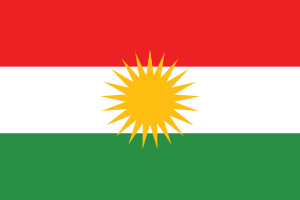Kurds in Armenia
| Languages | |
|---|---|
| Kurdish, Armenian | |
| Religion | |
| Sunni Islam and Shia Islam | |
| Related ethnic groups | |
| Iranian people |

The Kurds in Armenia mainly live in the western parts of Armenia. The Kurds of the former Soviet Union first began writing Kurdish in the Armenian alphabet in the 1920s, followed by Latin in 1927, then Cyrillic in 1945, and now in both Cyrillic and Latin. The Kurds in Armenia established a Kurdish radio broadcast from Yerevan and the first Kurdish newspaper Rya Taza. There is a Kurdish Department in the Yerevan State Institute of Oriental studies. The Kurds of Armenia were the first exiled country to have access to media such as radio, education and press in their native tongue[1] but many Kurds, from 1939 to 1959 were listed as the Azeri population or even as Armenians.[2][3]
Kurds in Armenia
The historically suspicious treatment from Armenia toward local Kurds, especially Muslim Kurds, is best explained as a reaction to the fact that most Kurdish tribes in (what was then) Western Armenia participated along with the Turks of the Ottoman Empire during the deportation and genocide of the Armenian populations during the first world war (World War I).
In the Democratic Republic of Armenia of 1918–1920 the Kurds received political rights: a Kurdish representative elected to the Armenian parliament, some Kurds became officers of Armenian army and organized Kurdish volunteer units.[4]
During the Soviet period a large number of Kurdish literature was published in Armenia, national schools and radio were opened. According to the Great Soviet Encyclopedia, the Soviet Armenia was the main center of Kurdish literature.[5] In 1925 more than fifty schools were opened for the Kurds of Armenia.[6]
During the period of stalinism in 1937, the Kurds in Armenia became victims of forced migration, thousands of Kurds were forcibly deported from Armenia.[7][8]
According to the director of the Center of Kurdish research, the situation with Kurds in Armenia today is normal and there is not any open untolerance.[9]
In the period between 1992-94 the Kurdish population of Lachin and Kelbajar districts of Azerbaijan was forced to flee due to Armenian invasion during the Nagorno-Karabakh War. Armenia has effectively occupied the former region Red Kurdistan as it is used as a crucial land corridor that connects Armenia with the Nagorno-Karabakh Republic.
Kurdish-Armenian cultural relations
Prominent Armenian composer Komitas notated many Kurdish folk songs included "Lur dalur". Komitas was a guest of Hasan-agha in Aslan village, where he participated at the Kurdish evenings. Komitas loved the Kurdish popular art and in 1897 he made a diploma research at Frederick William University, Berlin on Kurdish music.[10] Armenian writer Vrtanes Papazian translated the legend of "Lur dalur" into Armenian.
Armenian poet Hovhannes Shiraz used the motives of Kurdish legend in his famous poem "Siamanto and Khjezare".
Prominent Kurds of Armenia
- Najm ad-Din Ayyub and his brother, Shirkuh, who were born near the ancient city of Dvin (near the present-day village of the same name). Ayyub's son, Saladin[11][12] would establish a dynasty under his father's name and led the Islamic opposition to the Franks and other European Crusaders in the Levant.
See also
- Armenian Genocide
- Hamidiye (cavalry)
References
- ↑ The Peoples of the USSR: An Ethnographic Handbook - P. 117. by Ronald Wixman
- ↑ Mannerheim: Marshal of Finland - P. 210. by Alexandre Bennigsen, Stig Jägerskiöld, S. Enders Wimbush
- ↑ http://web.archive.org/web/20070710071814/http://www.osce.org/documents/oy/2002/01/148_en.pdf
- ↑ Гажар Аскеров КУРДСКАЯ ДИАСПОРА
- ↑ Kurds at Great Soviet Encyclopedia
- ↑ Encyclopedia of World Cultures - P 225. by David Levinson
- ↑ "(McDowall - A Modern History of the Kurds, page 492)"
- ↑ Kurdish Culture and Society: An Annotated Bibliography - P. 22. by Lokman I. Meho, Kelly L. Maglaughlin
- ↑ Шакро Мгои: «После распада СССР многие курды так и не получили гражданства России»/ Noev Kovcheg, #13, 2006
- ↑ (in Russian) An interview with Charkaz Rash // ДРУЖБА, №22, 2003
- ↑ "Encyclopedia of World Biography on Saladin". Retrieved 2008-08-20.
- ↑ The medieval historian Ibn Athir relates a passage from another commander: "...both you and Saladin are Kurds and you will not let power pass into the hands of the Turks." Minorsky (1957).
